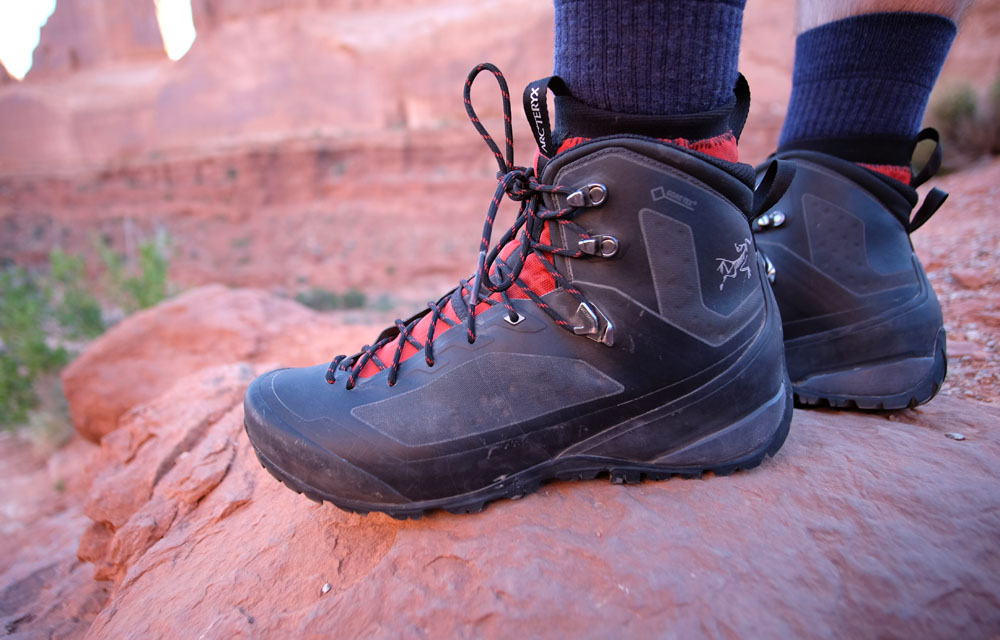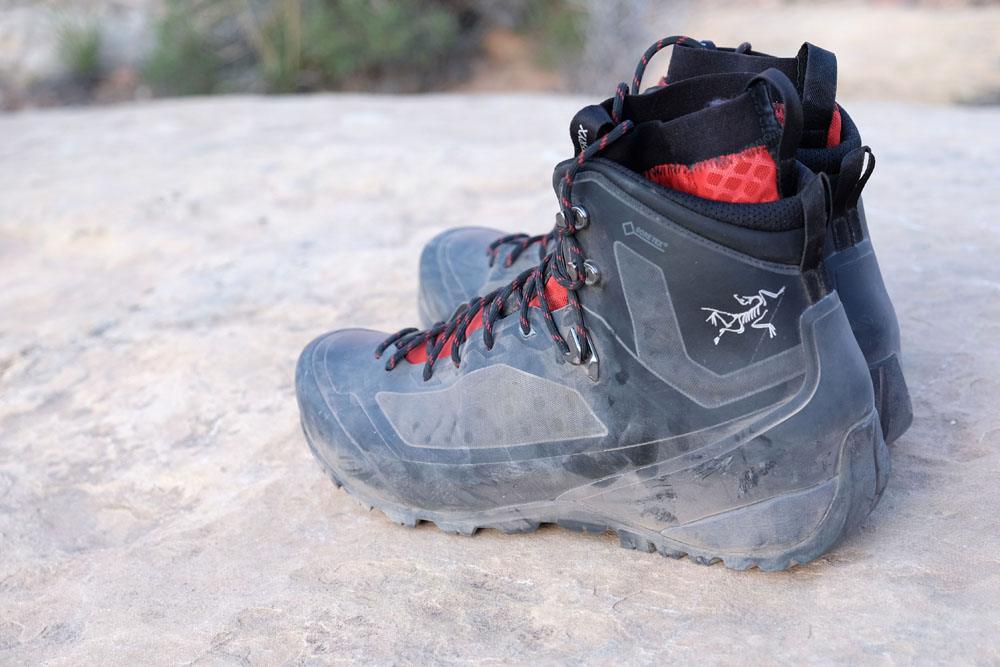

David Wilkinson


David Wilkinson
Arc’teryx made the jump into footwear last year, and to little surprise, mimicked no one in the process. The Bora2 Mid GTX hiking boots combine the protection and grip of an approach shoe with the comfort of a lightweight trail boot. Unique removable liners can be cleaned or swapped out for insulated versions, and they manage to function seamlessly with the exterior boot for levels of performance that we have come to expect from Arc’teryx. These boots are pricey, but if you’re planning serious hiking or backpacking on rocky terrain, they are up to the task. Below we break down the Bora2's construction, traction, waterproofness, breathability, fit, and more. To see how the boot stacks up, see our comparison table and article on the best hiking boots.
Arc’teryx isn’t afraid to be bold, which is very evident in the Bora2 Mid GTX. One of the most notable features is the Gore-Tex stretch micromesh liner, which functions like a high-end bootie that is fully removable. The sponge-like liner breathes extremely well, is waterproof, and has minimized seams. You can simply take them out for cleaning or to wear around camp, or eventually swap them out after heavy use. Arc’teryx also sells an insulated version for cold weather.

The exterior of the boot looks like an approach shoe, with thick rubber around the foot. We put these boots to the test in terms of scrambling and contact with rocks and other debris, and they provided excellent protection. In addition, we were surprised at how well the two parts of the boots moved together—the removable liner caused no issues in terms of performance.
The Arc’teryx Bora2 Mid GTX provide superb traction, particularly over rock. The lugs are decently large and grippy, and the Vibram insoles have no problem tackling steep inclines and declines—important characteristics for backpacking-ready footwear. We became so comfortable with the Bora2 on numerous types of rock in the canyon country of Utah that it wasn’t until we switched shoes that we realized just how superior the traction is.

By foregoing a tongue, the waterproofing duties fall pretty squarely on the liner, with help from the thermolaminated outer shell. The Gore-Tex liners are fully waterproof and have minimized seams to further lessen ways for water to penetrate the boots. In addition, the liners sit higher on the leg than other boots on the market. You get a mini gaiter effect here, with another inch or so of protection above the cuff of the boot that you wouldn’t normally get.
Following our first look, we had some concerns about breathability and heat retention. With a rubbery exterior and waterproof liner, they seemed prone to overheating, so to give them a proper test we packed them for three days of backpacking in Utah with temperatures expected in the low 80’s. To our surprise, the boots were more breathable and less hot than the lightweight hiking shoes we had along for comparison on the trip.

The separate Gore-Tex liner breathes well and is more effective at wicking moisture than a standard built-in Gore-Tex bootie. Granted, all waterproof hiking footwear can feel hot to some degree when you’re really working and putting on miles, but at the end of our trip, we left suitably impressed with the performance of the Arc’teryx Bora2.
Support is one of the areas that surprised us most. Despite a tough appearance that would lead you to believe the boots are stiff, the Bora2s provide medium levels of support. They have a fair amount of give in the ankles, which we found helpful for maneuvering on rock and in tight spots. While wearing a heavy pack, the boots were stiff enough that we never felt they were too weak. The same story is felt underfoot, with plenty of flex for quick scrambling, as well as sufficient protection for multi-day trekking over tough terrain.
We carried a heavy pack while wearing the Bora2s (at times exceeding 50 pounds) and had no issues with the lack of stiffness. However, if you are particularly prone to ankle issues and prefer boots with a high level of support, we recommend looking to another hiking boot option.

Take the lower portion of an approach shoe, add in a higher ankle, and you get the Bora2. In addition to the burly toe and heel, the Bora2 offers superb levels of protection around the sides of the foot. At about mid-foot height, the boot does become a little less rigid and the outer shell is a bit thinner. This, combined with more minimal padding around the ankles does mean that the Bora2s aren’t in the same league for ankle protection as a full-on backpacking boot. For most, this is a non-issue, and we were not left wanting any additional cushioning after some tough backpacking miles in Canyonlands.
The Arc’teryx Bora2 Mid GTX weighs 3 lb. 2 oz. for the pair, putting them on par with another lightweight backpacking boot, the Salomon Quest 4D 2 (see our in-depth review), but still a bit heavy for such a flexible shoe. You do, however, get far more protection and a better fit than comparable boots, along with reliable traction underneath.

The Arc’teryx Bora2 Mid GTX run pretty true to size—they are slightly larger than average but not enough to make us bump down a half size. In terms of comfort, the boots exceeded our expectations. Our editors were a bit skeptical that the Bora would feel clunky compared to the lighter weight trail shoes that are so popular these days.
To the contrary, the soft stretch liner was extraordinarily comfortable and our feet felt great upon arriving at camp despite not breaking the boots in before the trip. The liners act as a buffer for your foot, and you don’t get rubbing or hot spots like you might with other boots. We did notice that it is easier to put on the liner first and then slide it into the exterior shell (we struggled a bit when trying to put them on together).

| Boot | Price | Category | Weight | Waterproof | Upper |
|---|---|---|---|---|---|
| Arc'teryx Bora2 Mid GTX | $330 | Midweight | 2 lb. 12 oz. | Yes (Gore-Tex) | PU coated textile |
| Salomon Quest 4D 2 GTX | $230 | Midweight | 2 lb. 13 oz. | Yes (Gore-Tex) | Nubuck leather / mesh |
| Lowa Renegade GTX Mid | $230 | Midweight | 2 lb. 7 oz. | Yes (Gore-Tex) | Nubuck leather |
| Salewa Mountain Trainer Mid | $239 | Midweight | 2 lb. 12 oz. | Yes (Gore-Tex) | Suede leather |
| Asolo Fugitive GTX | $240 | Heavyweight | 3 lb. 1 oz. | Yes (Gore-Tex) | Suede leather / nylon |
Considering the outside-the-box design and high price tag, it’s not a big surprise the Bora2 doesn’t have that many direct competitors. Among backpacking boots, the Salomon Quest 4D, Lowa Renegade and Asolo Fugitive are some of our favorite models (in that order). The Bora2 stands apart from them with its burly textile upper material and sock-like fit, but all three competitors cost $100 less, weigh about the same, and are all the average backpacker will ever need. Salewa makes a backpacking boot that performs a lot like an alpine approach shoe, the Mountain Trainer Mid, but despite similarities in the level of protection, the Bora2 is still a different animal.
Given the high cost of these boots and the level of protection, the Bora2 is overkill for easy trails (your average soft dirt trails near cities that essentially are groomed), and we struggle to recommend it for these uses at over $300. Where you’ll get your money’s worth—and where the Bora2 doesn’t really have much competition—is on rocky and off-trail terrain. Prime locations and uses that come to mind are peak bagging in the Rocky Mountains (U.S. and Canada), scrambling on Utah slickrock, and hiking in tough and rocky alpine environments like Alaska, Norway, Patagonia or Nepal.
Arc’teryx released a series of hiking boots and the Bora2 Mid GTX is the most expensive of the bunch. The Bora Mid GTX (no “2”) does not have a removable liner and is about $50 cheaper, but we like the flexibility and think this feature is worth it. As a result, only the Bora2 model made our annual list of the best hiking boots. The rest of the line is approach shoes with lower cuffs just above the ankle: the Acrux2 FL GTX has a removable liner and the Acrux FL GTX does not. As of press time, women’s versions are available in both the Bora hiking boots and Acrux approach shoes, and now include the Bora2 removable liner option.
If you’re thinking about buying gear that we’ve reviewed on Switchback Travel, you can help support us in the process. Just click on any of the seller links above, and if you make a purchase, we receive a small percentage of the transaction. The cost of the product is the same to you but this helps us continue to test and write about outdoor gear. Thanks and we appreciate your support!
Depending on the seller, most products ship free in the United States on orders of $50 or more. International shipping availability and rates vary by seller. The pricing information on this page is updated hourly but we are not responsible for inaccuracies.